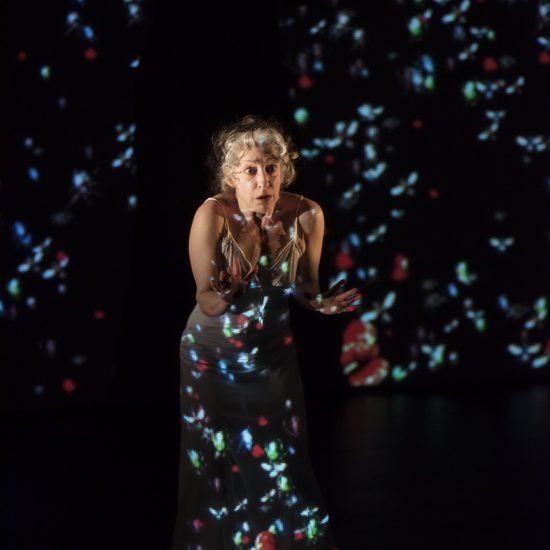A performer finds herself on stage in front of an audience…with no idea of what she’s supposed to do. Realizing this is a recurring nightmare, she records the story into what seems to be a Dictaphone – but it’s not – and whatever it is leads her into a hair-raising series of everything that can go wrong in a stage performance.
She then finds herself in the family nest, floating on love… then on a dock, singing the blues with Barak Obama (her recurrent lover). Guided by a faceless statue, she adventures through wild flowers, spattered blood and puffed cereal. She is attacked by shoes and occasionally soothed by the vestige of her long deceased father.
Yes…this woman is DREAMING.
Pillow Talk, an Essay on Dreaming is a story about how we cope with life’s challenges every night, when our inner theatre’s curtain rises. Comedies and tragedies in every style imaginable come to us (for free!) to tickle us out of our troubles or shake us to the core. We are surprisingly funny, violent, pitiful or courageous…we are complete artists…we can even create God.
It is a true story, built on a collection of real dreams recorded in a Dictaphone tucked under my pillow. Whether we remember them or not, whether we can make sense out of them or not, dreams are at the heart of our capacity to create, to think, to learn…and to survive.
But why do we have to tell ourselves crazy stories each night in order to survive?
Who knows? Rather than try to interpret these dreams analytically, I choose to interpret them artistically. Dreams can speak to us in the same way that works of art do. We can appreciate them with our innate sense of metaphor and poetry.

The evening began with Pillow Talk, an essay on dreaming, by Dulcinea Langfelder – a playful and colorful multi-disciplinary work. As the title indicates, the piece treats the universal subject of dreaming, taken on by the artist in a most lively and dazzling way. How do you consciously bring the unconscious to an audience? Ultra expressive, Langfelder plunges into an exploration of her own dreams, which, rather than analyze, she interprets on stage, with lightness and gaiety…
La Pieuvre

After reading everything I can find about dream research (and working with my own dreams) what is clear to me is that dreaming is at the heart of our capacity to make something out of life. Dreaming (and daydreaming) is how we invent things and solve problems. Our dreaming brain is our own personal therapist, asking: haven’t we seen this kind of predicament before? How did we deal with it last time?
Whether we remember them or not, whether we can make sense out of them or not, dreams keep us sane, maintain our instincts and above all, develop our creativity. As one of my favorite dreams recounts: Like a stretched canvas, the scene goes back up on the mountain cliff, and it’s stretched out to me. That’s how I do it.
How do we live and grow? We imagine. We dream. That’s how we do it.
Sweet dreams!

Concept, choreography and interpretation : Dulcinea Langfelder
Direction and choreography : Alice Ronfard and Anne Sabourin
Animations: Dulcinea Langfelder and Benjamin Broche
Sound engineer: Danys Levasseur
Video projections: Patrice Daigneault
Lighting and projections : Vincent Santes
Videos consultants: Yves Labelle and Jules de Niverville
Sound: Hans Nasserdine Djafer and Bruno Lavoie
Thanks also to: Alice Ronfard, Marylène Breault, Yves Labelle, Jules de Niverville, Ana Capellutto and Sophie El-Assaad










